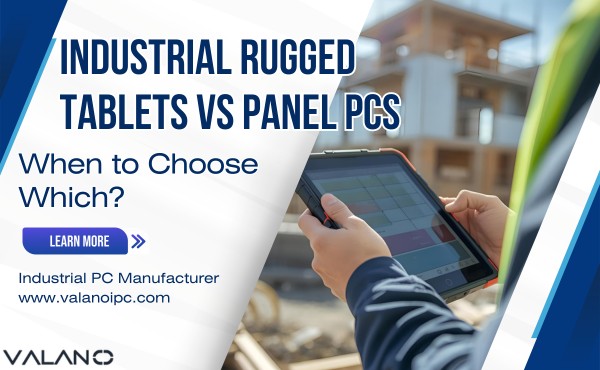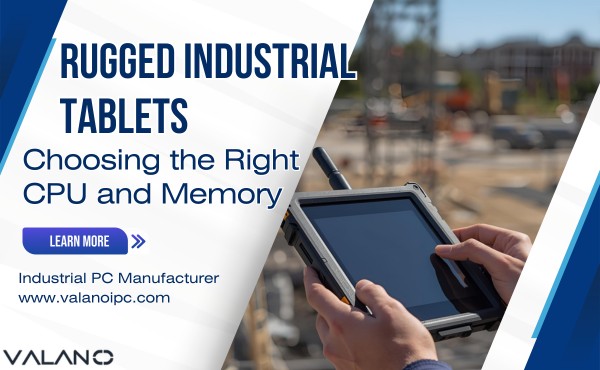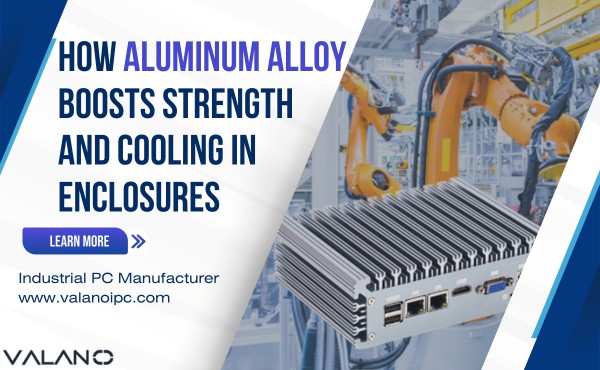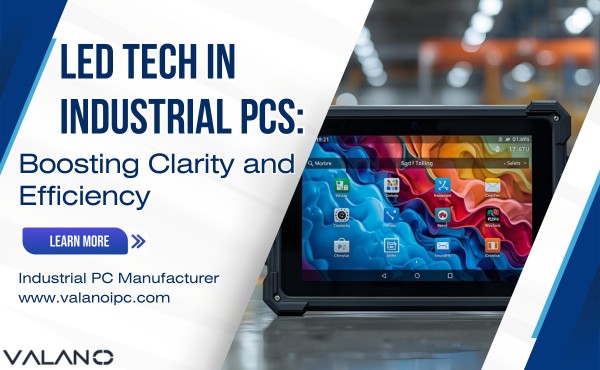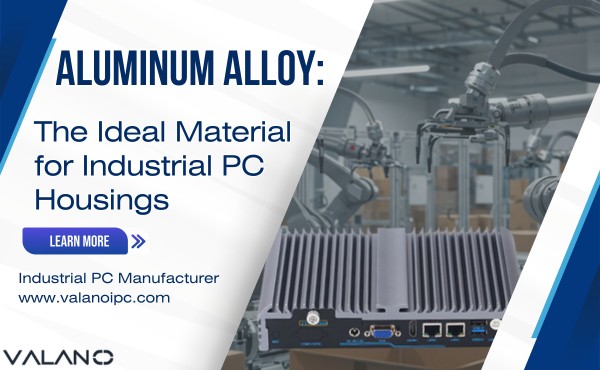Understanding the difference between a workstation and an industrial computer is essential for choosing the right system.
Workstations are designed for high-speed processing and advanced graphics, ideal for creative and engineering tasks in controlled office environments. In contrast, industrial computers are built to withstand extreme conditions like dust, vibration, and temperature fluctuations, ensuring reliable performance in factories and outdoor locations.
This comparison helps you identify which system fits your workflow and environment for maximum efficiency and durability.
Key Difference Between Workstation and Industrial Computer
The difference between workstation and industrial computer stands out in three main areas: performance, ruggedness, and certifications. Each type of system serves a unique purpose. Users should understand these differences before making a choice.
| Feature | Workstation | Industrial Computer Workstations |
|---|---|---|
| Performance | High computing power for design, engineering, and graphics tasks | Reliable operation for control, monitoring, and automation |
| Ruggedness | Standard build for office use | Built to withstand dust, vibration, temperature, and moisture |
| Certifications | Follows general safety and quality standards | Meets strict industrial certifications for harsh environments |
Performance
A workstation delivers strong processing power. It handles tasks like 3D modeling, video editing, and scientific calculations. Industrial computer workstations focus on stable performance in factories or plants. They may not match the speed of a workstation, but they run reliably for long periods.
Ruggedness
Workstations usually stay in clean, climate-controlled offices. They do not need extra protection from dust or shocks. Industrial computer workstations have tough cases. They resist heat, cold, dust, and vibration. This makes them ideal for use on factory floors or outdoor sites.
Certifications
Workstations follow common safety and quality rules. These rules work well for most office settings. Industrial computer workstations must pass strict tests. These tests check if the system can survive in extreme conditions. Certifications prove that the system meets industry standards for safety and reliability.
Tip: Always check the certifications before choosing a system for a harsh environment.
Usage Scenarios
Workstation Uses
A workstation supports professionals in fields like engineering, architecture, and media production. Designers use a workstation for tasks such as 3D modeling and video editing. Many teams rely on a mobile workstation when they need high performance outside the office.
Note: A mobile workstation offers flexibility for users who travel or work at multiple locations.
Industrial Computer Uses
Industrial computers operate in factories, warehouses, and outdoor facilities. These systems control machinery, monitor production lines, and collect data from sensors. Workers depend on industrial computer workstations for reliable performance in environments with dust, vibration, or extreme temperatures.
Environment
The environment shapes the choice between workstation and industrial computer. Offices and studios provide clean, climate-controlled spaces for workstation use. Industrial computer workstations thrive in places where moisture, heat, or movement could damage regular computers.
- Offices, labs, and studios suit workstation deployment.
- Factories, plants, and outdoor sites require industrial computer workstations.
- Mobile workstation models help users who need power and portability in changing environments.
Tip: Always match the computer type to the demands of the workspace for best results.
Physical Design
Size and Form Factor
Workstations often have a tower or desktop shape. These systems fit well under desks or on tables in offices. Industrial computer workstations come in many shapes, such as compact boxes or rack-mounted units. Some models use fanless designs to reduce noise and dust intake. Mobile workstation models offer a portable option for users who need high performance outside the office.
| Type | Typical Size | Form Factor |
|---|---|---|
| Workstation | Large tower, desktop | Standard, slim |
| Industrial Computer | Compact, rugged | Box, rack, panel |
| Mobile workstation | Laptop-sized | Portable |
Tip: Users should check the available space before choosing a system. A mobile workstation saves space and offers flexibility.

Ports and Mounting
Workstations provide many ports for monitors, printers, and other devices. These systems support USB, HDMI, and Ethernet connections. Industrial computers include extra ports for sensors, controllers, and industrial equipment. Some models feature legacy ports for older machines. Mounting options differ between types. Workstations usually sit on desks or under tables. Industrial computer workstations mount on walls, racks, or inside control panels. Mobile workstation models include ports for both office and field use.
- Workstations: Multiple USB, HDMI, and audio ports.
- Industrial computer: Specialized ports for industrial devices.
- Mobile workstation: Mix of standard and rugged ports for travel.
Note: The right ports and mounting options help users connect all needed devices and keep the workspace organized.
Internal Hardware
CPU and GPU
Workstations use powerful CPUs and GPUs. These components help users complete tasks like rendering graphics and running simulations. Industrial computers use CPUs designed for stability and long-term operation. Some models include basic GPUs for simple visual tasks.
| Component | Workstation | Industrial Computer |
|---|---|---|
| CPU | High-speed, multi-core | Stable, energy-efficient |
| GPU | Advanced, supports 3D and video | Basic, supports simple displays |
Workstations often feature CPUs with many cores. This design speeds up complex calculations. Industrial computers focus on reliability over raw speed. They use CPUs that can run for years without failure.
Tip: Users who need fast graphics should choose a workstation with a strong GPU.
Cooling
Workstations use advanced cooling systems. These systems include fans, heat sinks, and sometimes liquid cooling. Cooling keeps the CPU and GPU at safe temperatures during heavy use.
Industrial computers use cooling methods built for harsh environments. Many models use fanless designs. This approach reduces dust intake and lowers the risk of mechanical failure.
- Workstations: Multiple fans, heat pipes, liquid cooling.
- Industrial computers: Fanless, passive cooling, rugged heat sinks.
Cooling affects system lifespan. Good cooling prevents overheating and keeps hardware running smoothly.
Note: Fanless cooling works best in dusty or dirty locations.
Reliability
Reliability matters in both workstations and industrial computers. Workstations use high-quality parts to reduce crashes and data loss. Industrial computers use components rated for continuous operation.
Industrial computers often include features like error-correcting memory and redundant power supplies. These features help prevent downtime in critical settings.
| Feature | Workstation | Industrial Computer |
|---|---|---|
| Error-correcting memory | Sometimes included | Common |
| Redundant power | Rare | Often included |
| Long-term operation | Good | Excellent |
Reliability ensures that users can trust their systems to work when needed. Industrial computers offer extra protection for mission-critical tasks.
Standards
Industrial Certifications
Industrial computers must meet strict standards. These standards ensure safe and reliable operation in tough environments. Common certifications include IP ratings for dust and water resistance, as well as standards for shock and vibration.
Many factories require industrial computer workstations to pass tests for electromagnetic interference. These tests help prevent problems with other machines. Some certifications also check for safe operation in areas with chemicals or high temperatures.
Tip: Always check the certification labels before installing a system in a factory or outdoor site.
Workstation Compliance
A workstation usually follows general safety and quality rules. These rules focus on safe use in offices, labs, or studios. Most workstations meet basic electrical and safety standards set by national or international groups.
Workstations do not need the same level of ruggedness as industrial computer workstations. They do not require special tests for dust, moisture, or vibration. Users should still look for systems that meet recognized safety standards for peace of mind.
Note: Choosing a compliant workstation helps protect both users and data in professional settings.
Workstation vs. Industrial Computer: Which One to Choose
User Needs
Selecting the right computer starts with understanding user needs. Some users require high-speed processing for design, modeling, or data analysis. Others need a system that can survive dust, vibration, or extreme temperatures.
A workstation suits professionals who work in clean offices or studios. These users often need strong graphics and fast calculations. Industrial environments demand computers that can operate without interruption, even in harsh conditions.
Tip: Users should list their daily tasks and the challenges of their workspace before making a decision.
Best Fit
The best system depends on the environment and the type of work. A workstation fits jobs that involve creative software, engineering tools, or scientific research. It offers the power and speed needed for complex projects.
Industrial computers work best in factories, warehouses, or outdoor sites. These systems handle control, monitoring, and automation tasks. They resist damage from dust, moisture, and movement.
| Environment | Best Choice | Main Benefit |
|---|---|---|
| Office/Studio | Workstation | High performance |
| Factory/Warehouse | Industrial Computer | Rugged reliability |
| Mobile/Field Work | Mobile Workstation | Power and portability |
Users should match the system to their main tasks and the risks in their environment. A workstation delivers speed and graphics for creative work. Industrial computers provide steady operation in tough places.
Note: Choosing the right system helps users avoid downtime and get the best results from their investment.
Summary Table
| Feature | Workstation | Industrial Computer |
| Purpose | High performance for design, engineering, and graphics tasks | Reliable operation in harsh industrial environments (control, monitoring, automation) |
| Performance | Powerful CPUs and GPUs for complex tasks (3D modeling, video editing, simulations) | Stable, energy-efficient CPUs; basic GPUs for simple display needs |
| Ruggedness | Standard build, designed for clean, climate-controlled offices | Rugged cases resistant to dust, vibration, temperature, moisture |
| Certifications | General safety and quality standards for office use | Strict industrial certifications (IP ratings, EMI resistance, shock/vibration tests) |
| Environment | Offices, studios, labs | Factories, plants, outdoor sites |
| Form Factor | Large tower or desktop | Compact box, rack-mounted, panel |
| Ports & Mounting | Standard USB, HDMI, Ethernet | Specialized ports for industrial devices; mounting on racks or panels |
| Cooling | Advanced cooling (fans, heat sinks, sometimes liquid) | Fanless or passive cooling, rugged heat sinks |
| Reliability Features | High-quality parts, occasional error-correcting memory | Common ECC memory, redundant power supplies, built for long-term continuous operation |
| Usage Scenarios | Creative and technical professionals (engineering, media, design) | Industrial automation, control, data collection in harsh settings |
| Main Benefit | Speed and power for demanding creative and technical tasks | Rugged reliability and stable operation in harsh environments |
Conclusion
Workstations deliver high performance for creative and technical tasks in clean environments. Industrial computers provide rugged reliability for harsh settings like factories or outdoor sites.
Each system suits different needs and workspaces. Users should review their daily tasks and environment before choosing a computer. The right choice helps users work efficiently and avoid problems.




